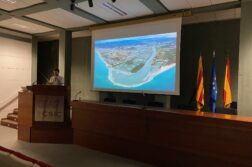Biodiversity loss is a global concern due to the ever-increasing pressures of human activities on worlds ecosystems. Non-indigenous species (NIS) are one of the greatest drivers of biodiversity loss and ecosystem change. Despite recent research progress in many areas of invasion science, little is known about how temporal dynamics (e.g. time lag, time since the first introduction) mediate invasion success.
To fill this gap TEMPOINVASIONS will use the latest molecular tools to analyse sedimentary sequences from well-preserved sites along the Spanish coast (Cádiz bay, Cabo de Gata, Ebro Delta). We will focus on the past six centuries when major translocation of marine species started due to the beginning of the transoceanic exploration.
Sediment DNA (sedaDNA) extractions will be performed using established protocols in the amplicon- and culture-free laboratory of the Clean DNA Lab at CEAB. We will extract nucleic acids using the Qiagen DNeasy PowerSoil DNA Elution Kit to isolate ancient sedaDNA in a dedicated amplicon-free laboratory room at CEAB. We will use metabarcoding approaches based on a suite of primers that collectively allow biodiversity assessment across taxonomic levels from the same samples. These include the standard barcoding region of the COI gene (for metazoans) and the hypervariable v4 region of the nuclear 18S ribosomal DNA (for a wide range of protists and other eukaryotes). We will multiplex sequence using Illumina NovaSeq technologies to conduct multi-gene metabarcoding and to both determine community composition at different times and establish when NIS were introduced. We will use existing bioinformatic pipelines in the cluster of the Biological Computational Lab at CEAB to both determine community composition at different times and establish when NIS appeared and disappeared.
This community-wide approach will also allow testing if the structure of native communities has been altered. TEMPOINVASIONS will be a step change on our understanding of the temporal dimension of biological invasions (through the integration of palaeoecological and molecular datasets) and will directly inform biodiversity conservation management actions



